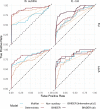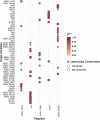BINDER: computationally inferring a gene regulatory network for Mycobacterium abscessus
- PMID: 31500560
- PMCID: PMC6734328
- DOI: 10.1186/s12859-019-3042-8
BINDER: computationally inferring a gene regulatory network for Mycobacterium abscessus
Abstract
Background: Although many of the genic features in Mycobacterium abscessus have been fully validated, a comprehensive understanding of the regulatory elements remains lacking. Moreover, there is little understanding of how the organism regulates its transcriptomic profile, enabling cells to survive in hostile environments. Here, to computationally infer the gene regulatory network for Mycobacterium abscessus we propose a novel statistical computational modelling approach: BayesIan gene regulatory Networks inferreD via gene coExpression and compaRative genomics (BINDER). In tandem with derived experimental coexpression data, the property of genomic conservation is exploited to probabilistically infer a gene regulatory network in Mycobacterium abscessus.Inference on regulatory interactions is conducted by combining 'primary' and 'auxiliary' data strata. The data forming the primary and auxiliary strata are derived from RNA-seq experiments and sequence information in the primary organism Mycobacterium abscessus as well as ChIP-seq data extracted from a related proxy organism Mycobacterium tuberculosis. The primary and auxiliary data are combined in a hierarchical Bayesian framework, informing the apposite bivariate likelihood function and prior distributions respectively. The inferred relationships provide insight to regulon groupings in Mycobacterium abscessus.
Results: We implement BINDER on data relating to a collection of 167,280 regulator-target pairs resulting in the identification of 54 regulator-target pairs, across 5 transcription factors, for which there is strong probability of regulatory interaction.
Conclusions: The inferred regulatory interactions provide insight to, and a valuable resource for further studies of, transcriptional control in Mycobacterium abscessus, and in the family of Mycobacteriaceae more generally. Further, the developed BINDER framework has broad applicability, useable in settings where computational inference of a gene regulatory network requires integration of data sources derived from both the primary organism of interest and from related proxy organisms.
Keywords: Bayesian inference; Data integration; Gene regulatory network; Mycobacterium abscessus.
Conflict of interest statement
The authors declare that they have no competing interests.
Figures










Similar articles
-
MICRAT: a novel algorithm for inferring gene regulatory networks using time series gene expression data.BMC Syst Biol. 2018 Dec 14;12(Suppl 7):115. doi: 10.1186/s12918-018-0635-1. BMC Syst Biol. 2018. PMID: 30547796 Free PMC article.
-
Genome-Wide Essentiality Analysis of Mycobacterium abscessus by Saturated Transposon Mutagenesis and Deep Sequencing.mBio. 2021 Jun 29;12(3):e0104921. doi: 10.1128/mBio.01049-21. Epub 2021 Jun 15. mBio. 2021. PMID: 34126767 Free PMC article.
-
DISTILLER: a data integration framework to reveal condition dependency of complex regulons in Escherichia coli.Genome Biol. 2009;10(3):R27. doi: 10.1186/gb-2009-10-3-r27. Epub 2009 Mar 6. Genome Biol. 2009. PMID: 19265557 Free PMC article.
-
Inferring regulatory networks.Front Biosci. 2008 Jan 1;13:263-75. doi: 10.2741/2677. Front Biosci. 2008. PMID: 17981545 Review.
-
Treatment of Mycobacterium abscessus Pulmonary Disease.Chest. 2022 Jan;161(1):64-75. doi: 10.1016/j.chest.2021.07.035. Epub 2021 Jul 24. Chest. 2022. PMID: 34314673 Review.
Cited by
-
Curation, inference, and assessment of a globally reconstructed gene regulatory network for Streptomyces coelicolor.Sci Rep. 2022 Feb 18;12(1):2840. doi: 10.1038/s41598-022-06658-x. Sci Rep. 2022. PMID: 35181703 Free PMC article.
-
Gene Regulatory Networks of Penicillium echinulatum 2HH and Penicillium oxalicum 114-2 Inferred by a Computational Biology Approach.Front Microbiol. 2020 Oct 27;11:588263. doi: 10.3389/fmicb.2020.588263. eCollection 2020. Front Microbiol. 2020. PMID: 33193246 Free PMC article.
References
-
- Baranyai Zsuzsa, Krátký Martin, Vinšová Jarmila, Szabó Nóra, Senoner Zsuzsanna, Horváti Kata, Stolaříková Jiřina, Dávid Sándor, Bősze Szilvia. Combating highly resistant emerging pathogen Mycobacterium abscessus and Mycobacterium tuberculosis with novel salicylanilide esters and carbamates. European Journal of Medicinal Chemistry. 2015;101:692–704. doi: 10.1016/j.ejmech.2015.07.001. - DOI - PubMed
-
- Miranda-CasoLuengo AA, Staunton PM, Dinan AM, Lohan AJ, Loftus BJ. Functional characterization of the Mycobacterium abscessus genome coupled with condition precise transcriptomics reveals conserved molecular strategies for host adaptation and persistence. BMC Genomics. 2016. 10.1186/s12864-016-2868-y. - PMC - PubMed
MeSH terms
LinkOut - more resources
Full Text Sources
Molecular Biology Databases

